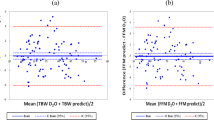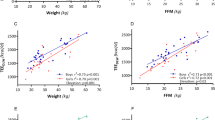Abstract
Background
For community-living older people, the ability to estimate total daily energy expenditure (TDEE) with validated predictive equations based on anthropometry is limited. To our knowledge no studies exist for non-Caucasian populations
Objective
To design and validate an anthropometry-based equation to estimate TDEE using doubly-labelled water (DLW) as the criterion measure, and to assess the performance of three other published equations in community-living older people from rural and urban areas of Brazil, Chile, Guatemala, Senegal, Cuba, and Mexico
Methods
This cross-sectional study measured anthropometry and TDEE using DLW in 69 men and 43 women aged 60–89 years. TDEE was also estimated with an anthropometry-based equation derived from the sub-sample of Mexico (n = 38) and with three other published equations. Predictive accuracy of the equations was tested by an external validation procedure
Results
TDEE by DLW in the six country sample was 2411 ± 41 kcal/day (mean ± SE) in men and 1939 ± 51 kcal/day in women. The best new Mexican equation was TDEE, kcal/d = [223.4 + (27.9 × weight, kg) + (239.7 × sex)]; where sex: Man = 1 and Woman = 0; having high precision; R2 = 0.89, lowest RMSE = 149.2, and Cp value of 2.0. This new Mexican equation estimated TDEE accurately in the five country sample and at country level after correction for Guatemalan older men, while the published equations performed poorly
Conclusions
The Mexican equation performed better that other published equations and is recommended to accurately estimate energy requirements for community-living older people in five Latin American and one African country.
This is a preview of subscription content, access via your institution
Access options
Subscribe to this journal
Receive 12 print issues and online access
$259.00 per year
only $21.58 per issue
Buy this article
- Purchase on Springer Link
- Instant access to full article PDF
Prices may be subject to local taxes which are calculated during checkout

Similar content being viewed by others
Data availability
The datasets used and/or analyzed during the current study are available from the corresponding author on reasonable request.
References
United Nations University, World Health Organization. Human Energy Requirements: Report of a Joint FAO/WHO/UNU Expert Consultation: Rome, 17-24 October 2001. Food & Agriculture Org., Rome, 2004. http://www.fao.org/3/y5686e/y5686e00.htm. Accessed 1 Apr 2020.
Food and Agricultural Organisation of the United Nations. Food-based dietary guidelines. 2018. http://www.fao.org/nutrition/nutrition-education/food-dietary-guidelines/en/. Accessed 1 Apr 2020.
Benziger CP, Roth GA, Moran AE. The Global Burden of Disease Study and the Preventable Burden of NCD. Glob Heart. 2016;11:393–7.
Black AE, Coward WA, Cole TJ, Prentice AM. Human energy expenditure in affluent societies: an analysis of 574 doubly-labelled water measurements. Eur J Clin Nutr. 1996;50:72–92.
Roberts SB, Dallal GE. Energy requirements and aging. Public Health Nutr. 2005;8:1028–36.
Aleman-Mateo H, Salazar G, Hernandez-Triana M, Valencia ME. Total energy expenditure, resting metabolic rate and physical activity level in free-living rural elderly men and women from Cuba, Chile and Mexico. Eur J Clin Nutr. 2006;60:1258–65.
Elia M, Ritz P, Stubbs RJ. Total energy expenditure in the elderly. Eur J Clin Nutr. 2000;54:S92–103.
Dugas LR, Harders R, Merrill S, Ebersole K, Shoham DA, Rush EC, et al. Energy expenditure in adults living in developing compared with industrialized countries: a meta-analysis of doubly labeled water studies. Am J Clin Nutr. 2011;93:427–41.
Gregory CO, Ramirez-Zea M, Martorell R, Stein AD. Activities contributing to energy expenditure among Guatemalan adults. Int J Behav Nutr Phys Act. 2007;4:48.
Coward WA, Roberts SB, Cole TJ. Theoretical and practical considerations in the doubly-labelled water (2H2(18)O) method for the measurement of carbon dioxide production rate in man. Eur J Clin Nutr. 1988;42:207–12.
International Atomic Energy Agency. Assessment of Body Composition and Total Energy Expenditure in Humans Using Stable Isotope Techniques. 2009. https://www.iaea.org/publications/7982/assessment-of-body-composition-and-total-energy-expenditure-in-humans-using-stable-isotope-techniques. Accessed 1 Apr 2020.
Porter J, Nguo K, Gibson S, Huggins CE, Collins J, Kellow NJ, et al. Total energy expenditure in adults aged 65 years and over measured using doubly-labelled water: international data availability and opportunities for data sharing. Nutr J. 2018;17:40.
Vinken AG, Bathalon GP, Sawaya AL, Dallal GE, Tucker KL, Roberts SB. Equations for predicting the energy requirements of healthy adults aged 18-81 y. Am J Clin Nutr. 1999;69:920–6.
Plucker A, Thomas DM, Broskey N, Martin CK, Schoeller D, Shook R, et al. Adult energy requirements predicted from doubly labeled water. Int J Obes (Lond). 2018;42:1515–23.
Goran MI, Poehlman ET. Total energy expenditure and energy requirements in healthy elderly persons. Metabolism. 1992;41:744–53.
United States Department of Agriculture. Rural Classifications. 2019. https://www.ers.usda.gov/topics/rural-economy-population/rural-classifications/. Accessed 17 July 2020.
Weir JB. New methods for calculating metabolic rate with special reference to protein metabolism. J Physiol. 1949;109:1–9.
Black AE, Prentice AM, Coward WA. Use of food quotients to predict respiratory quotients for the doubly-labelled water method of measuring energy expenditure. Hum Nutr Clin Nutr. 1986;40:381–91.
Ribas D, Spolidoro J, Lopes A, Marchini J. Gasto Energético Avaliado pela Calorimetria Indireta. http://www.saudediretacombr/docsupload/133132155633-Gastopdf.
Pontzer H. Energy expenditure in humans and other primates: a new synthesis. Annu Rev Anthropol. 2015;44:169–87.
Tabachnick BG, Fidell LS, Ullman JB. Testing hypotheses in mulitple regression. Using multivariate statistics, 6th ed. Pearson Boston, MA, 2013. p. 117–96.
Bland JM, Altman DG. Statistical methods for assessing agreement between two methods of clinical measurement. Lancet. 1986;1:307–10.
Ndahimana D, Go NY, Ishikawa-Takata K, Park J, Kim EK. Validity of the dietary reference intakes for determining energy requirements in older adults. Nutr Res Pract. 2019;13:256–62.
Porter J, Nguo K, Collins J, Kellow N, Huggins CE, Gibson S, et al. Total energy expenditure measured using doubly labeled water compared with estimated energy requirements in older adults (>/=65 y): analysis of primary data. Am J Clin Nutr. 2019;110:1353–61.
Heymsfield SB, Pietrobelli A. Body size and human energy requirements: Reduced mass‐specific total energy expenditure in tall adults. Am J Hum Biol. 2010;22:301–9.
Gatica-Domínguez G, Victora C, Barros AJ. Ethnic inequalities and trends in stunting prevalence among Guatemalan children: an analysis using national health surveys 1995–2014. Int J Equity Health. 2019;18:110.
Guo SS, Chumlea WC. Statistical methods for the development and testing of predictive equations. In: Roche AF, Heymsfield SB, Lohman TG (eds). Human Body Composition. Human Kinetics: Champaign, IL, USA, 1996, p. 191–202.
Acknowledgements
The authors thank all the volunteers in all the study countries and the many authorities responsible for the clinics and research centers where research was conducted. We also thank the Directors of all the participating institutions for supporting the study. In Mexico, we thank Alma E. Robles-Sardin, M.Sc., and Bertha I. Pacheco Moreno for their technical support, and Rogelio González Arellanes, M.Sc., for his critical review of the text. In Chile, we thank Alyerina Anziani, who performed the IRMS analyses for four countries.
Funding
This research was supported by funding from the International Atomic Energy Agency (IAEA) (Research contract No. 12694/R0).
Author information
Authors and Affiliations
Contributions
The authors’ responsibilities were as follows—HAM, MRZ, EF, RNN: significantly contributed to research design; MRZ, HAM, EF, RNN, MEV, JER, MHT, LEAR and GS: significantly contributed to data collection; EF and GS: significantly contributed to sample analysis by IRMS and interpretation; HAM, and JER, significantly contributed to statistical analyses and interpretation of results; HAM significantly contributed to the writing paper; ER, MHT, GS, MRZ: significantly contributed to the editing of the final paper; MEV and ER were the expert consultants contracted by the IAEA.
Corresponding author
Ethics declarations
Conflict of interest
The authors declare no competing interests.
Additional information
Publisher’s note Springer Nature remains neutral with regard to jurisdictional claims in published maps and institutional affiliations.
Rights and permissions
About this article
Cite this article
Alemán-Mateo, H., Antúnez-Roman, L.E., Esparza-Romero, J. et al. A new doubly labelled water anthropometry-based equation for prediction of total daily energy expenditure in older people from low- and middle-income countries. Eur J Clin Nutr 75, 1618–1626 (2021). https://doi.org/10.1038/s41430-021-00886-6
Received:
Revised:
Accepted:
Published:
Issue Date:
DOI: https://doi.org/10.1038/s41430-021-00886-6



